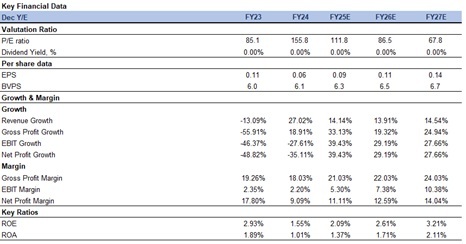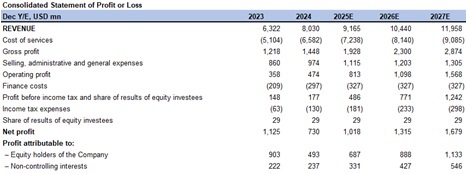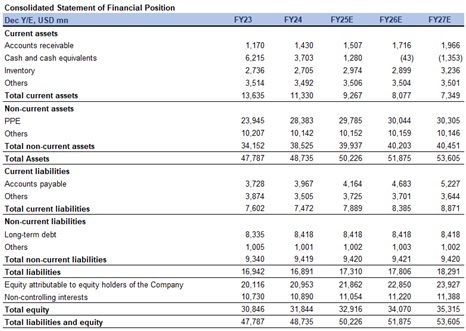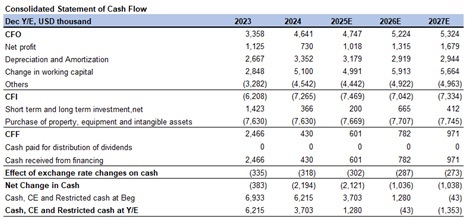-
Products
- Local Securities
- China Connect
- Grade Based Margin
- Stock Borrowing & Lending
- IPO
- Stock Options
- Foreign Stocks
- Unit Trust
- Local Futures
- Foreign Futures
- Forex
- Bullion
- Insurance Services
- Bond
- Monthly Investment Plan
- Mortgage
- Other Services
- Surplus Cash Facility
- Phillip Premier
- Latest Insurance Promotion<
- ETF
- Smart Minor (Joint) Account
- Capital Management
- Research
- Market Info
- Education Center
- Phillip Apps
- Customer Service
- About Us
-
Surplus Cash Facility
Research Report
SMIC (00981.HK) - Capacity expansion slows, while product mix begins to improve
Monday, October 20, 2025  1092
1092
SMIC(981)
| Recommendation | Accumulate |
| Price on Recommendation Date | $73.900 |
| Target Price | $87.000 |
Weekly Special - 3750 CATL
Financial performance
In the first half of 2025, the company achieved revenue of $4.5 billion (USD, same below), a year-on-year increase of 22.0%. The gross profit margin was 21.4%, up 7.6 percentage points year-on-year. Profit before tax was $510 million, a year-on-year increase of 95.0%. Net profit attributable to the parent company was $320 million, a year-on-year increase of 35.6%.
In the second quarter of 2025, the company achieved revenue of $2.2 billion, a quarter-on-quarter decrease of 1.7%. This was primarily due to a 6.4% quarter-on-quarter decrease in ASP, while the number of wafers sold increased by 4.3% quarter-on-quarter to 2.39 million 8-inch equivalent wafers, mainly driven by inventory replenishment. By application segment, management stated that the revenue contributions from smartphones, computers & tablets, consumer electronics, connectivity & wearables, and industrial & automotive were 25%, 15%, 41%, 8%, and 11%, respectively. The company's automotive electronics product shipments continued steady growth, with primary revenue contributions coming from automotive-grade chips such as analog/power management, image sensors, logic-embedded memory, and controllers. The overall automotive segment grew 20% quarter-on-quarter in Q2. The revenue contribution from 8-inch and 12-inch wafers was 24% and 76%, respectively. The absolute revenue from 8-inch wafers increased by 7% quarter-on-quarter, with capacity utilization outperforming peers. The company's gross profit margin for Q2 was 20.4%, down 2.1 percentage points quarter-on-quarter, mainly due to decreased ASP caused by production volatility and product mix changes. Capacity utilization was 92.5%, up 2.9 percentage points quarter-on-quarter, with utilization rates for both 8-inch and 12-inch wafers improving further. As of the end of Q2, the company's monthly capacity reached 991,000 8-inch equivalent wafers. Profit before tax was $160 million, a quarter-on-quarter decrease of 54.1%. Net profit attributable to the parent company was $130 million, a quarter-on-quarter decrease of 29.5%.
The company guides for Q3 2025 revenue to increase by 5%-7% quarter-on-quarter, expecting both shipment volume and ASP to rise, reflecting an improving product mix alongside capacity expansion. The gross margin is guided between 18% and 20%, flat with the Q2 guidance, mainly due to increased depreciation from new capacity, though the improved product mix enhances profitability. Affected by the industry's traditional slow season, inventory was built up in the first three quarters to support customer demand pull-ins. Although customer confidence remains strong, the pace of urgent orders and demand pull-ins is expected to slow somewhat in Q4. Management indicated that as the company overall remains in a state of tight supply, the slowdown in shipment pace will not significantly impact capacity utilization. Based on the above, and assuming no major changes in the external environment, the company's full-year target remains to exceed the average of comparable peers.
Investment thesis
Based on SMIC's recent slower capacity expansion pace and management's more conservative outlook for 2H25E and 3Q25E revenue, we adjust the company's 2025-2027 revenue forecasts to $9.2 billion / $10.4 billion / $12.0 billion, respectively. We forecast net profit attributable to the parent company to be $687 million / $888 million / $1.133 billion for 2025/2026/2027, corresponding to EPS of $0.09 / $0.11 / $0.14. Overall, as a leading player in the foundry segment, we believe the company's reasonable valuation is slightly above one standard deviation of its historical average NTM P/B ratio, at 1.8x 2025 forecasted P/B. This corresponds to a target price of HKD 87 per share. We adjust our rating to 'Accumulate'.
Risk factors
1) Tightening of U.S. export controls;
2) Lower-than-expected ramp-up of capacity at the Wuxi wafer fab;
3) Weaker-than-expected increase in ASP.
Financials




(Current Price as of: 16 Oct 2025)
Source: PSHK Est.
This report is produced and is being distributed in Hong Kong by Phillip Securities Group with the Securities and Futures Commission (“SFC”) licence under Phillip Securities (HK) LTD and/ or Phillip Commodities (HK) LTD (“Phillip”). Information contained herein is based on sources that Phillip believed to be accurate. Phillip does not bear responsibility for any loss occasioned by reliance placed upon the contents hereof. The information is for informative purposes only and is not intended to or create/induce the creation of any binding legal relations. The information provided do not constitute investment advice, solicitation, purchase or sell any investment product(s). Investments are subject to investment risks including possible loss of the principal amount invested. You should refer to your Financial Advisor for investment advice based on your investment experience, financial situation, any of your particular needs and risk preference. For details of different product's risks, please visit the Risk Disclosures Statement on http://www.phillip.com.hk. Phillip (or employees) may have positions/ interests in relevant investment products. Phillip (or one of its affiliates) may from time to time provide services for, or solicit services or other business from, any company mentioned in this report. The above information is owned by Phillip and protected by copyright and intellectual property Laws. It may not be reproduced, distributed or published for any purpose without prior written consent from Phillip.
Top of Page
|
Please contact your account executive or call us now. Research Department Tel : (852) 2277 6846 Fax : (852) 2277 6565 Email : businessenquiry@phillip.com.hk Enquiry & Support Branches The Complaint Procedures |
About Us Phillip Securities Group Join Us Phillip Network Phillip Post Phillip Channel Latest Promotion 新闻稿 |
E-Check Login |
Investor Notes Free Subscribe |

|




